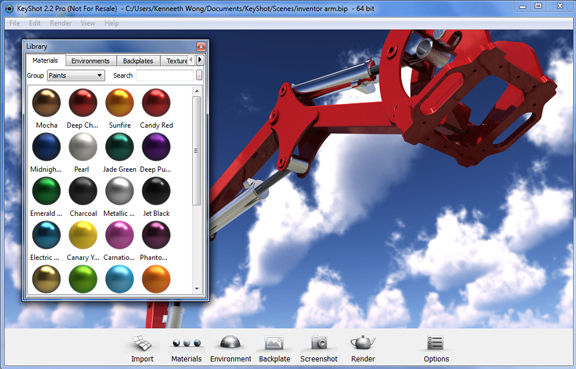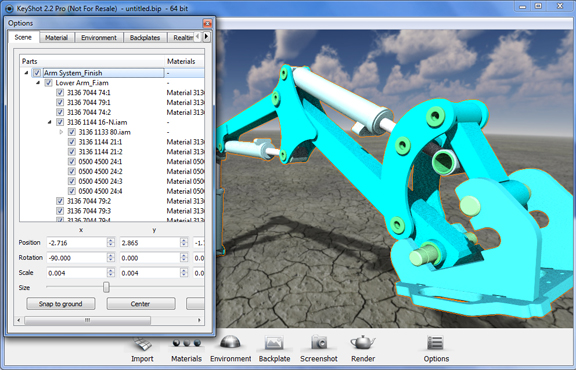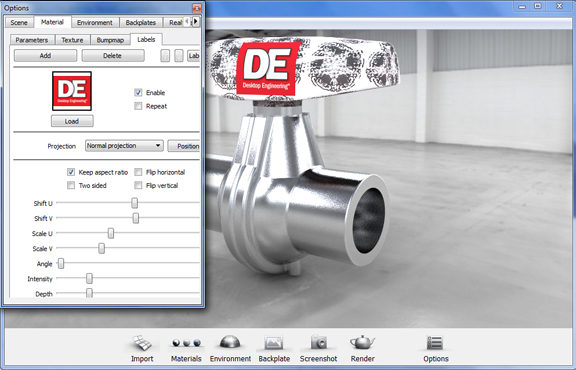March 24, 2011



Luxion KeyShot, one of the offshoots of HyperShot, is now in its second incarnation. To be exact, it’s in Version 2.2, with incremental upgrades sprinkled over the past few months to bring it to where it is now. A major improvement in the latest version is the smoother, faster import function. Now, when you import a CAD assembly, you’ll see a model tree with the same assembly structure inside KeyShot. During import, the program gives you options to place the model at the center of the scene (or not), snap the model to the ground (or not), and orient the model by a certain axis (X up, Y up, or Z up). This eliminates the work you would otherwise need to do to position and align the model in the scene before applying aesthetic treatments.
KeyShot continues its tradition, dating back to its origin as a rendering program for those with little or no experience. With robust support for common CAD file formats, KeyShot remains one of the most accessible rendering packages for those who regularly work with mechanical modeling programs.
The program retains its drag-and-drop simplicity, allowing you to apply materials, environment, backdrops, then render the visible scene in the program window into a photo-realistic image. No need to understand ray-tracing, Gama adjustment, and other technical setups. The simple slider bars and real-time feedback let you work intuitively by experimentation to compose the scene with the right brightness, camera angle, and materials.
In Version 2.2, the hierarchical assembly structure imported along with the model gives you a simpler way to sort, identify, and apply attributes to different parts of your model. Furthermore, items selected in the model tree are encircled by a yellow outline in the program window, which makes isolating them much easier. If you often deal with complex assemblies and you’re used to identifying items by name (part number, for instance), you’ll find this enhancement a huge help.
In Version 2.2, you’ll find that the Move and Scale commands are much more responsive. You’ll also notice some interface improvements: among them, an easy to way to select standard camera views (Front, Left, Right, Top, Back, and so on) from a drop-down menu; and a single-click button to center your geometry.
Though not highly publicized, it’s worth noting that KeyShot gives you the option to select a small region for test-rendering. Under Render > Render Settings > Region, if you place a checkmark in the Enable box, you’ll be able to drag a selection window to define the region you want to render. If you’re concerned about the details in a certain region in your scene, and you don’t want to wait till the entire scene has been rendered to inspect the area, the regional rendering option works well as a way to test-render the chosen area.
Previously, to project a 2D image on the model’s 3D surface, you had to load the image as a texture in the material editing window. Though it gave you the result you wanted, the method also left you without a way to apply texture once the slot was occupied by the projected 2D image. In Version 2.2, KeyShot gives you the ability to apply labels—more than one, if you want—to your material. Not only is the operation simpler, it also gives you the option to apply texture to your material in addition to labels.
Since both Luxion KeyShot and its main rival Bunkspeed SHOT claim to be descendants of HyperShot, you’ll inevitable wonder: how do I decide which one to go with? The primary distinction may be the choice of hardware. KeyShot relies primarily on CPU; SHOT uses both CPU and GPU. Rendering a model using CPU and rendering it using GPU appear to produce identical results; however, if the software code is designed for parallel processing, it tends to render at a greater speed on special GPUs designed to accommodate multi-threading (for example, professional-class NVIDIA GPUs with CUDA). The performance gap between multi-core CPUs and GPUs may also become narrower as Intel works to add on-board HD graphics to its upcoming CPUs. Therefore, your hardware configuration and preference may offer better clues on which package to go with.
For more about the history of Luxion KeyShot and Bunkspeed SHOT, read “One Scene, Two Shots,” July 2010.
For more on Bunkspeed SHOT, read a recent review by Mark Clarkson, published in January 2011.
For more on KeyShot 2.2, watch the video report below.
Subscribe to our FREE magazine, FREE email newsletters or both!
About the Author
Kenneth Wong is Digital Engineering’s resident blogger and senior editor. Email him at [email protected] or share your thoughts on this article at digitaleng.news/facebook.
Follow DE





